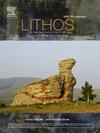Data-driven expeditious mapping and identifying granites in covered areas via deep machine learning: A case study on the implications for geodynamics and mineralization of Eastern Tianshan
IF 2.9
2区 地球科学
Q2 GEOCHEMISTRY & GEOPHYSICS
引用次数: 0
Abstract
Mapping granites and identifying their genetic types are critically important for understanding the tectonic evolution and patterns of metallogenesis of a defined region. This is because granite usually serves as a significant geological probe enabling us to track and examine the process of crustal accretion and recycling in various geodynamic contexts. However, even geological mapping of granite, especially at large regional scales, in areas covered by regolith, vegetation, water, or ice, remains a considerably challenging task due to the coverage, resulting in incomplete surveys originating from inaccessible measurements. Therefore, we proposed a data-driven framework that utilizes the deep learning method to integrate multi-source survey data, including geophysical, geochemical, and remote sensing data, to map granites and identify their genetic types in covered areas. For demonstration purposes, the Gobi-desert covered area of the Eastern Tianshan orogenic belt, which is an important mineralization belt and exhibits a complex tectonic evolution, with extensive exposures of various genetic granites primarily formed during the Late Paleozoic, has been used as a case study. Using Bouguer gravity, aeromagnetic, geochemical data for stream sediments, and remote sensing data as predictors, we built two fully-connected deep neural networks for mapping undiscovered granites and identifying their genetic types in the study area, respectively. We applied the synthetic minority over-sampling technique to balance the data related to genetic types of granite. This study demonstrates that the proposed deep machine learning framework is a powerful data-driven tool for laborless and expeditious mapping of granite lithology and identifying genetic types in covered areas. It develops a novel model for the tectonic evolution history of the Eastern Tianshan from the perspective of the spatiotemporal distribution of granites with different origins. This model reveals the metallogenic patterns and exploration potential of magmatic-hydrothermal deposits related to granite in the Eastern Tianshan region.
求助全文
约1分钟内获得全文
求助全文
来源期刊

Lithos
地学-地球化学与地球物理
CiteScore
6.80
自引率
11.40%
发文量
286
审稿时长
3.5 months
期刊介绍:
Lithos publishes original research papers on the petrology, geochemistry and petrogenesis of igneous and metamorphic rocks. Papers on mineralogy/mineral physics related to petrology and petrogenetic problems are also welcomed.
 求助内容:
求助内容: 应助结果提醒方式:
应助结果提醒方式:


